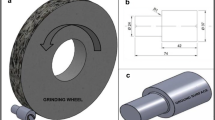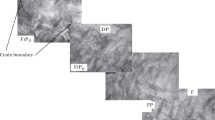Abstract
In the present paper, residual stresses induced by honing processes on hardened steel cylinders were determined. Cubic boron nitride (CBN) abrasives were employed. Both surface measurements and depth profiles were obtained by means of XRD. SEM observations were performed on samples’ surface. Roughness and material removal rate were also measured. Compressive residual stresses, which are known to increase fatigue life of components, were reported both in the axial and in the tangential direction. Shearing stresses were negligible. If only rough honing is taken into account, as a general trend, the lower cutting conditions used, the higher surface stresses are. A similar situation was found when only semifinish or only finish honing is considered. In most cases studied, stress profiles similar to those obtained in grinding processes, in which compressive stresses decrease with depth, were observed. However, in rough honing at hard cutting conditions, a typical hook-shaped profile was found with maximum compressive stress at 80-μm depth. Such shape is usual in turning processes. In order to obtain high surface stresses a rough, semifinish or finish honing operation with low cutting conditions is recommended. However, if stresses are to be obtained at a certain depth, rough honing at high cutting conditions is to be selected.
Similar content being viewed by others
References
Arrazola PJ, Özel T, Umbrello D, Davies M, Jawahir IS (2013) Recent advances in modelling of metal machining processes. CIRP Ann Manuf Technol 62(2):695–718. doi:10.1016/j.cirp.2013.05.006
Brinksmeier E, Cammett JT, König W, Leskovar P, Peters J, Tönshoff HK (1982) Residual stresses—measurement and causes in machining processes. CIRP Ann Manuf Technol 31(2):491–510. doi:10.1016/S0007-8506(07)60172-3
Denkena B, Breidenstein B (2008) Influence of the residual stress state on cohesive damage of PVD‐coated carbide cutting tools. Adv Eng Mater 10(7):613–616. doi:10.1002/adem.200800063
Fergani O, Shao Y, Lazoglu I, Liang SY (2014) Temperature effects on grinding residual stress. In: Procedia CIRP 14:2–6. doi:10.1016/j.procir.2014.03.100
Jawahir IS, Brinksmeier E, M’Saoubi R, Aspinwall DK, Outeiro JC, Meyer D, Jayal AD, Umbrello D (2011) Surface integrity in material removal processes: recent advances. CIRP Ann Manuf Technol 60(2):603–626. doi:10.1016/j.cirp.2011.05.002
Kermouche G, Rech J, Hamdi H, Bergheau JM (2010) On the residual stress field induced by a scratching round abrasive grain. Wear 269(1–2):86–92. doi:10.1016/j.wear.2010.03.012
Köhler J, Grove T, Maiß O, Denkena B (2012) Residual stresses in milled titanium parts. Procedia CIRP 2:79–82. doi:10.1016/j.procir.2012.05.044
Matsumoto Y, Barash MM, Liu CR (1986) Effect of hardness on the surface integrity of AISI 4340 steel. J Eng Ind 108(3):169. doi:10.1115/1.3187060
Matsumoto Y, Hashimoto F, Lahoti G (1999) Surface integrity generated by precision hard turning. CIRP Ann Manuf Technol 48(1):59–62. doi:10.1016/S0007-8506(07)63131-X
Matsumoto Y, Magda D, Hoeppner DW, Kim TY (1991) Effect of machining processes on the fatigue strength of hardened AISI 4340 steel. J Eng Ind 113(2):154. doi:10.1115/1.2899672
Meng-yang Q, Bang-yan Y, Xiong J, Ai-dong H (2012) Experimental investigation of residual stress distribution in pre-stress cutting. Int J Adv Manuf Technol 65(1–4):355–361. doi:10.1007/s00170-012-4174-4
Rech J, Kermouche G, Grzesik W, García-Rosales C, Khellouki A, García-Navas V (2008) Characterization and modelling of the residual stresses induced by belt finishing on a AISI52100 hardened steel. J Mater Process Technol 208(1–3):187–195. doi:10.1016/j.jmatprotec.2007.12.133
Sosa AD, Echeverría MD, Moncada OJ, Sikora JA (2007) Residual stresses, distortion and surface roughness produced by grinding thin wall ductile iron plates. Int J Mach Tools Manuf 47(2):229–235. doi:10.1016/j.ijmachtools.2006.04.004
Tönshoff HK, Hetz F (1987) Influence of the abrasive on fatigue in precision grinding. J Eng Ind 109(3):203. doi:10.1115/1.3187119
Author information
Authors and Affiliations
Corresponding author
Rights and permissions
About this article
Cite this article
Buj-Corral, I., Vivancos-Calvet, J., Setien, I. et al. Residual stresses induced by honing processes on hardened steel cylinders. Int J Adv Manuf Technol 88, 2321–2329 (2017). https://doi.org/10.1007/s00170-016-8870-3
Received:
Accepted:
Published:
Issue Date:
DOI: https://doi.org/10.1007/s00170-016-8870-3




